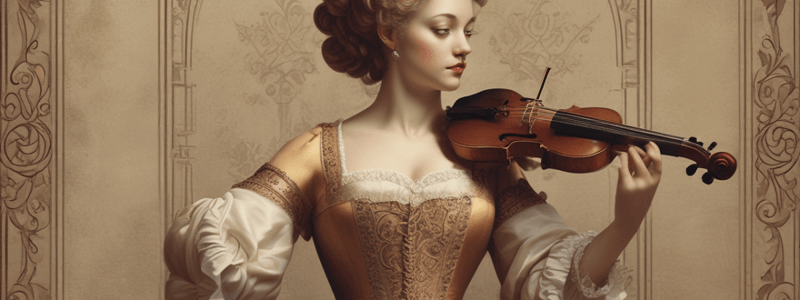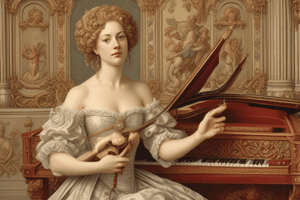Podcast
Questions and Answers
What is a key element of Baroque aesthetics?
What is a key element of Baroque aesthetics?
- The integration of nature and architecture (correct)
- The emphasis on simplicity
- The use of abstract shapes
- The use of pastel colors
What is the purpose of dramatic elements in Baroque architecture?
What is the purpose of dramatic elements in Baroque architecture?
- To create a sense of calm
- To reduce the importance of nature
- To highlight the beauty of the surrounding landscape
- To create a sense of awe and wonder (correct)
How are the gardens at Isola Bella laid out?
How are the gardens at Isola Bella laid out?
- In a random, naturalistic way
- In a spiral shape
- In ten terraces, resembling a stepped pyramid (correct)
- In a circular pattern
What is the effect of the terraced layout in the gardens of Isola Bella?
What is the effect of the terraced layout in the gardens of Isola Bella?
What can be found in the gardens of Isola Bella?
What can be found in the gardens of Isola Bella?
What is a characteristic of the plan of the gardens at Isola Bella?
What is a characteristic of the plan of the gardens at Isola Bella?
What contrast is highlighted by the geometric plan of the gardens?
What contrast is highlighted by the geometric plan of the gardens?
What is emphasized by the contrast between the gardens and the natural landscape?
What is emphasized by the contrast between the gardens and the natural landscape?
What is the overall style of the architecture and gardens at Isola Bella?
What is the overall style of the architecture and gardens at Isola Bella?
What is the effect of the statues, obelisks, and fountains in the gardens of Isola Bella?
What is the effect of the statues, obelisks, and fountains in the gardens of Isola Bella?
Flashcards are hidden until you start studying
Study Notes
Baroque Music and Architecture
Characteristics of Baroque Music
- Spanned from 1600 to 1750
- Characterized by dramatic expression, ornate ornamentation, and contrast to evoke emotion
- Saw the birth of the orchestra and new musical forms like opera and concerto
- Harmonic system that dominates Western music was established
- Composers like Bach, Handel, and Vivaldi epitomized the Baroque style
History of Opera
- Originated in Florence at the end of the 16th century
- The Camerata, a group of intellectuals and musicians, played a crucial role in its development
- First opera, "Dafne," was composed by Jacopo Peri and performed in Florence around 1597
- Italy remained the center of opera development, with Venice becoming a major hub
- Later, opera spread to France, England, and German-speaking areas
History of the Violin
- Emerged in Italy during the Renaissance period
- Cremona became the center of violin making, with other towns in northern Italy also playing a significant role
- Andrea Amati developed the prototypes for the violin, viola, and violoncello in Cremona
- The development of the large bass violin (or double bass) is not clearly established
History of the Pianoforte
- Spans several centuries of evolution in musical instrument technology and design
- Developed from early keyboard instruments like the harpsichord and clavichord
- Bartolomeo Cristofori, an Italian harpsichord maker, built the first prototype around 1700
- Cristofori's innovation was the use of a hammer mechanism that struck the strings, allowing for dynamic volume
Composers of the Baroque Period
- Domenico Scarlatti: Italian composer known for his keyboard music, particularly his 555 keyboard sonatas
- Antonio Vivaldi: Italian Baroque composer, violinist, and teacher; wrote over 500 concertos, 46 operas, and numerous sacred choral works
Baroque Architecture
Characteristics of Baroque Architecture
- Emerged in the late 16th century and flourished in the 17th and early 18th centuries
- Characterized by extravagant decoration, curves, painted ceilings, dramatic use of light, bold ornamentation, and a sense of movement and grandeur
- Uses natural light to create dramatic contrasts and highlight architectural elements
- Combines architecture, painting, sculpture, and decorative arts into a cohesive whole
St. Peter's Basilica
- One of the most renowned works of Renaissance and Baroque architecture
- Represents a synthesis of Renaissance and Baroque architectural styles
- Features a massive dome designed by Michelangelo, a facade designed by Carlo Maderno, and a piazza designed by Gian Lorenzo Bernini
- Combines Renaissance and Baroque elements, embodying the artistic and structural advancements of the period
Baroque Gardens
-
Became outdoor extensions of the interior living spaces of a villa
-
Often enormous and complex, with statuary, water features, and sweeping vistas
-
Italian Baroque gardens broke down the wall between the garden, the house, and the landscape outside
-
Vatican Gardens: a place of reflection and retreat for the Popes since the early 13th century, featuring chapels, grottoes, and monuments
-
Isola Bella: a prime example of Baroque architecture and formal gardens on a small island in Lake Maggiore### Villa Borromeo and Its Gardens
-
Construction of Villa Borromeo began in 1632 by Carlo III di Casa Borromeo and spanned 40 years, finally inaugurating the gardens in 1671.
-
The villa became a popular venue for lavish parties and theatrical events for European nobility.
Architecture and Design
- The palace showcases grandeur and dramatic flair typical of Baroque architecture.
- Features of the palace include grand staircases, richly decorated rooms, and intricate frescoes.
- Interiors are lavishly decorated with stucco, tapestries, and period furniture.
- The halls and galleries are adorned with paintings and sculptures by renowned artists of the time.
Berthier Gallery
- The Berthier Gallery is an impressive art museum within the palace.
- It features original works and handmade copies of famous pieces commissioned by the rich to display in their homes.
- Every space in the gallery is decorated, reflecting the era's aversion to undecorated space.
Isola Bella's Natural Setting
- The design of Isola Bella takes full advantage of the island's natural setting, offering stunning views of Lake Maggiore and the surrounding mountains.
- The integration of nature and architecture is a key element of Baroque aesthetics.
Gardens
- The gardens are laid out in ten terraces, resembling a stepped pyramid, creating a dramatic and theatrical effect.
- The terraced layout is a hallmark of Baroque garden design.
- The gardens feature numerous statues, obelisks, and fountains designed to impress and delight visitors.
- The gardens follow a highly symmetrical and geometric plan, with precisely aligned pathways, flowerbeds, and water features, contrasting with the natural landscape and emphasizing the Baroque emphasis on control and artifice.
Studying That Suits You
Use AI to generate personalized quizzes and flashcards to suit your learning preferences.




